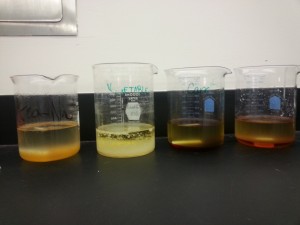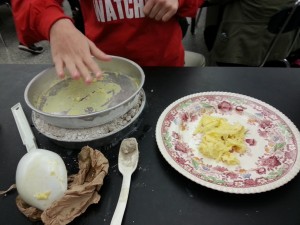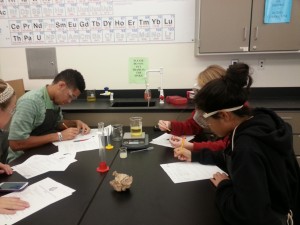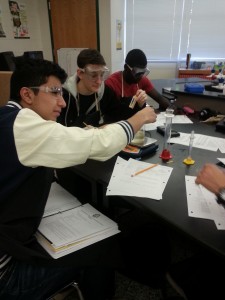Whew!
A new unit worked into the very end of my semester has been a challenge. I’ve decided for this blog post to share some things that worked well as well as some things that did not.
My students were very active and engaged when I had them brainstorm answers to the introductory questions about energy. I showed them the photopeach video I created and they ended up in a lively discussion about where energy comes from and whether or not it is manmade. The photopeach video link is http://photopeach.com/album/h5ew30. As expected, they did not mention any type of biofuel or alternatives to petroleum, as energy sources. One activity I used as a demonstration was frying an egg with calcium oxide and water. The reaction is so exothermic that it can cook an egg. Look at the picture below – my kids all circled around and were completely amazed at how fast it happened!
Another highlight for them was making the biodiesel. I was awarded a grant from NCSTA for $1000 to purchase equipment for the lab. Students chose canola, peanut, vegetable, or sunflower oil as their starting material. I made the oil on a Friday, which was a good idea because it had all weekend to sit and separate. I had been worried about the safety of making the fuel in the classroom, but I went over all the safety precautions with students and they took them seriously – to the point of being paranoid, which I did not mind. Dr. Schimmel came to visit the day we made the biodiesel. It was nice for students to have a chance to talk with him and ask him questions during lab, as well as to have another set of eyes during the lab. Another positive was my assessment. I chose to have each student write a reflection on whether or not widespread use of biodiesel was a good option for the United States. I encouraged them to support their opinions with facts and I got some good insight from them.
The challenges for me were mainly with our time. As I mentioned, this unit was at the end of the semester, when I was already pressed for time. Working in the additional activities for biodiesel required more time than I originally planned for the unit. I realized my students needed more information about petroleum in order to form their own opinions about its use. They were more interested in learning about the production of biodiesel than the thermochemistry concepts. While I consider that a success, the thermochemical equations are part of the essential standards and I had to cover them. Next time, I may introduce petroleum and diesel as a mixture of compounds when I first teach formulas and nomenclature. I would also like to give them a day in class to research biodiesel production and facts. This semester, I gave them all the links to data, but they had to access them on their own. While their papers were decent, I would have liked the time to help them strengthen their responses.
In the end, the biggest success was that my students formed their own informed opinion about the production and use of biodiesel. They had some really good questions and were encouraged to find their own answers instead of just going with what someone else had told them. The area that still needs work is my pacing. I need to include time to cover the essential standards more thoroughly. I teach this class on a block schedule, so I will make some modifications to my schedule for the spring semester.



